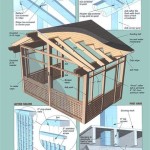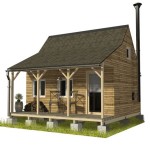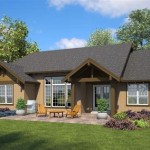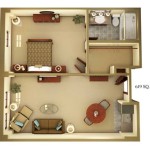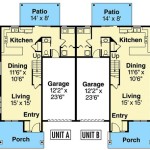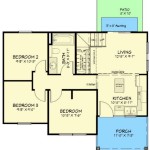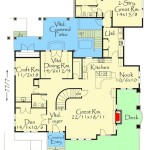Flat Roof Plans: A Modern Housing Trend
Flat roof plans are experiencing a resurgence in modern house design, moving beyond purely functional applications and becoming a defining aesthetic feature. This architectural choice, once relegated to commercial buildings or modernist experiments, now offers a blend of streamlined aesthetics, practical benefits, and innovative design possibilities for residential structures. Understanding the nuances of flat roof design, from structural considerations to material selection and maintenance strategies, is crucial for homeowners, architects, and builders considering this option.
The term "flat roof" is somewhat of a misnomer. In reality, no roof is perfectly flat. A slight pitch, typically a quarter inch per foot, is incorporated into the design to ensure adequate water drainage. This subtle slope prevents water from pooling on the roof surface, which can lead to structural damage, leaks, and the growth of mold and mildew. The minimal slope maintains the clean lines associated with flat roofs while addressing the practical need for water runoff. The success of a flat roof hinges on meticulous planning and execution, taking into account local climate conditions, building codes, and the overall architectural style of the house.
Advantages of Flat Roofs in Modern House Design
Flat roofs offer a number of advantages that contribute to their growing popularity in modern house design, spanning both aesthetic and functional realms. These benefits, when carefully considered and properly implemented, can significantly enhance the value, livability, and sustainability of a home.
One significant benefit is the maximization of usable space. Unlike pitched roofs, flat roofs do not create unusable attic space. This allows for a more efficient use of the entire building envelope. The roof surface itself can be transformed into a usable space, such as a rooftop garden, a deck, or an outdoor entertainment area. This is particularly beneficial in urban environments where land is at a premium.
Flat roofs also facilitate easier installation and maintenance of mechanical systems. HVAC units, solar panels, and other equipment can be placed on the roof without the need for complex bracketing or modifications often required with pitched roofs. Accessibility for maintenance and repairs is also significantly improved, reducing the cost and effort associated with these tasks. The flat surface provides a stable platform for workers and equipment, making routine inspections and repairs safer and more efficient.
From a design perspective, flat roofs contribute to a clean, minimalist aesthetic that is characteristic of modern architecture. The horizontal lines of the roof create a sense of spaciousness and can visually lengthen the building. This design element works well with large windows, open floor plans, and other features commonly found in modern homes. The sleek silhouette of a flat roof allows the building to seamlessly integrate into its surroundings, particularly in urban and suburban landscapes. The simplicity of the design also allows for greater flexibility in the overall architectural style, accommodating a wide range of materials and finishes.
Essential Structural Considerations for Flat Roof Construction
Constructing a durable and reliable flat roof requires careful attention to structural integrity. The roof must be able to withstand the weight of snow, wind, and rain, as well as any additional loads from rooftop gardens or equipment. A well-engineered structural system is crucial for preventing leaks, sagging, and other problems that can compromise the building's integrity.
The structural system typically consists of joists, beams, and columns that support the roof deck. The size and spacing of these elements will depend on the span of the roof, the anticipated loads, and the materials used. Steel, concrete, and engineered wood products are commonly used for structural support in flat roof construction. Each material offers different advantages in terms of strength, durability, and cost. Steel, for example, provides exceptional strength and is resistant to fire, while concrete offers excellent thermal mass and sound insulation. Engineered wood products, such as laminated veneer lumber (LVL) and glued laminated timber (glulam), offer a sustainable and cost-effective alternative to solid lumber.
The roof deck, which is the surface that covers the structural frame, is typically made of plywood or oriented strand board (OSB). The deck must be strong and stable enough to support the roofing membrane and any additional loads. It is essential to properly fasten the deck to the structural frame to prevent movement and ensure a watertight seal. The type of fasteners used will depend on the materials being joined and the anticipated loads. Screws, nails, and adhesives are commonly used to secure the roof deck to the structural frame.
Drainage is another critical structural consideration. As mentioned earlier, a slight slope is incorporated into the roof design to ensure that water flows towards drainage points. These drainage points can be located at the edges of the roof or in the center, depending on the size and shape of the roof. Gutters and downspouts are used to collect and divert water away from the building's foundation. The size and number of drainage points must be adequate to handle the maximum expected rainfall. Proper drainage is essential for preventing water damage and prolonging the lifespan of the roof.
Material Selection and Maintenance of Flat Roofs
The choice of roofing material is a crucial factor in the performance and longevity of a flat roof. Several types of materials are commonly used, each with its own advantages and disadvantages regarding cost, durability, and ease of installation. Proper maintenance is essential for preserving the integrity of the roofing material and preventing leaks and other problems.
Modified bitumen is a popular choice for flat roofs due to its durability, affordability, and ease of installation. This material is a asphalt-based product that is modified with polymers to improve its flexibility and resistance to weathering. Modified bitumen roofs are typically installed in multiple layers, providing a strong and waterproof barrier. The seams between the layers are heat-welded together, creating a seamless and watertight seal. Modified bitumen roofs can last for 10-20 years with proper maintenance.
TPO (thermoplastic polyolefin) is a single-ply roofing membrane that is known for its energy efficiency and durability. TPO is a synthetic rubber material that is resistant to UV radiation, chemicals, and punctures. It is typically installed in large sheets, reducing the number of seams and minimizing the risk of leaks. TPO roofs are also highly reflective, which can help to reduce energy costs by reflecting sunlight away from the building. TPO roofs can last for 20-30 years with proper maintenance.
EPDM (ethylene propylene diene monomer) is another single-ply roofing membrane that is known for its durability and resistance to weathering. EPDM is a synthetic rubber material that is highly flexible and can withstand extreme temperatures. It is typically installed in large sheets, similar to TPO, and is often used in commercial and industrial applications. EPDM roofs are relatively inexpensive and can last for 20-30 years with proper maintenance.
Regular maintenance is essential for extending the life of any flat roof. This includes inspecting the roof regularly for damage, cleaning debris from the roof surface, and repairing any leaks or damage promptly. It is also important to keep gutters and downspouts clean to ensure proper drainage. Regular inspections should be conducted at least twice a year, preferably in the spring and fall, to identify any potential problems before they become major issues. Addressing minor issues promptly can prevent costly repairs down the road. Professional inspections and maintenance are recommended for ensuring the long-term performance of the flat roof system.

Modern House Plans 11x10 5 Flat Roof 2 Bedrooms Samhouseplans

Exploring The Modern Appeal Of Flat Roof Home Designs Mcdonald Jones Homes

Simple And Beautiful House Design Flat Roof 2bedroom 14 4mx16 3m

Modern 5 Bedroom Double Y House Id 25506 Plans By Maramani

Ultimate Guide To Modern House Designs For Two Story Flat Roof Homes

Flat Roofs

Flat Roof House Plans Floor Designs Houseplans Com

Modern Flat Roof House Plans Pinoy Designs

Small House 3 Bedrooms Modern Simple Plan Flat Roof

Modern House Plans 10 7 5 With 2 Bedrooms Flat Roof Engineering Discoveries

